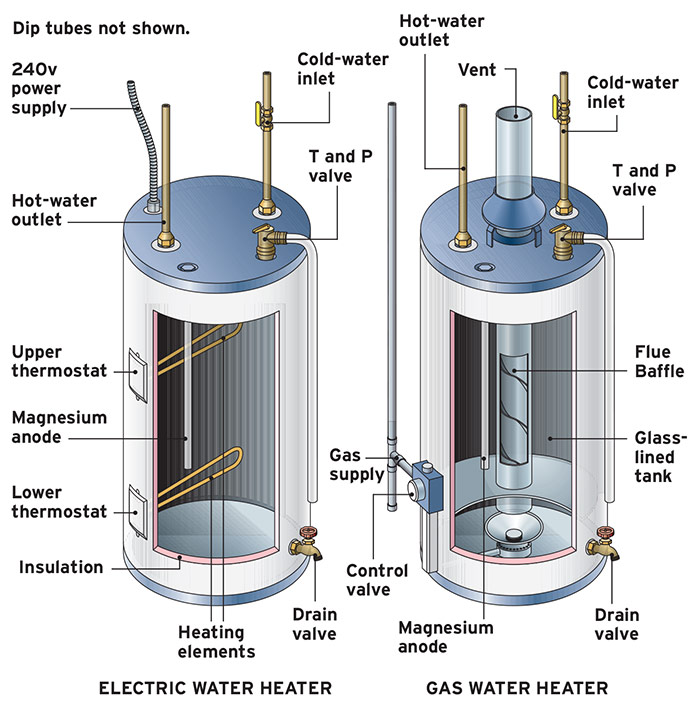
A water heater is an essential appliance in any modern home, providing the comfort of hot water for showers, laundry, and dishwashing. But like any mechanical device, water heaters can experience wear and tear over time. Understanding the various water heater parts is crucial for troubleshooting issues, performing maintenance, and ensuring your appliance operates efficiently. In this guide, we'll explore the key components of a water heater, their functions, and how to identify common problems.
Essential Components of a Water Heater
Whether you have a traditional tank-type water heater or a tankless model, certain core components are essential for its operation.
1. The Tank (For Tank-Type Heaters)
The tank is the heart of a traditional water heater. It's where water is stored and heated. Tanks are typically made of steel and lined with a protective material, such as glass or porcelain, to prevent corrosion. The size of the tank determines the amount of hot water available at any given time. Regularly checking the tank for leaks or signs of rust is essential for maintaining its integrity.
2. Heating Elements
Heating elements are responsible for heating the water in the tank. Electric water heaters use two heating elements, one near the top and one near the bottom, to ensure even heating. These elements are essentially resistors that convert electrical energy into heat. Over time, heating elements can burn out or become coated with mineral deposits, reducing their efficiency.
3. Thermostat
The thermostat controls the temperature of the water in the tank. It monitors the water temperature and cycles the heating elements on and off to maintain the desired setting. Adjusting the thermostat can help you conserve energy and prevent overheating. Faulty thermostats can lead to inconsistent water temperatures or a complete lack of hot water.
4. Dip Tube
The dip tube is a long pipe that extends from the top of the tank to near the bottom. Its function is to deliver cold water to the bottom of the tank, preventing it from mixing with the hot water at the top. A damaged or broken dip tube can cause lukewarm water or sediment buildup.
5. Anode Rod
The anode rod is a sacrificial rod that protects the tank from corrosion. It's typically made of aluminum, magnesium, or zinc and attracts corrosive elements in the water, preventing them from attacking the tank lining. Over time, the anode rod will corrode and need to be replaced. Regular inspection and replacement of the anode rod can significantly extend the life of your water heater.
6. Pressure Relief Valve (T&P Valve)

The pressure relief valve (also known as the temperature and pressure relief valve or T&P valve) is a safety device that prevents excessive pressure buildup in the tank. It releases water if the pressure or temperature exceeds safe limits. A malfunctioning T&P valve can lead to leaks or even a tank rupture.
7. Drain Valve
The drain valve is located at the bottom of the tank and is used to drain water for maintenance or sediment removal. Regularly flushing the tank through the drain valve can help prevent sediment buildup and improve efficiency.
8. Gas Valve and Burner (For Gas Water Heaters)
Gas water heaters have a gas valve that controls the flow of gas to the burner. The burner ignites the gas, which heats the water. These components should be regularly inspected for leaks or damage. A faulty gas valve or burner can lead to inefficient heating or safety hazards.
Common Water Heater Problems and Solutions
Understanding the function of each water heater part can help you diagnose and address common problems:
- No Hot Water: Check the thermostat, heating elements, and gas valve (if applicable).
- Lukewarm Water: Inspect the dip tube, thermostat, and heating elements.
- Leaking Tank: Look for signs of rust or corrosion. A leaking tank often requires replacement.
- Sediment Buildup: Flush the tank regularly through the drain valve.
- Strange Noises: Check for sediment buildup, faulty heating elements, or a malfunctioning T&P valve.
Maintenance Tips for Extending Water Heater Life
Regular maintenance can significantly extend the life of your water heater and ensure optimal performance:
- Flush the Tank: Drain a few gallons of water every few months to remove sediment.
- Inspect the Anode Rod: Check the anode rod annually and replace it as needed.
- Test the T&P Valve: Test the T&P valve periodically to ensure it's functioning correctly.
- Adjust the Thermostat: Set the thermostat to a moderate temperature (around 120°F) to conserve energy.
- Insulate the Tank: Insulating the tank can help reduce heat loss and improve efficiency.
By understanding the various water heater parts and performing regular maintenance, you can ensure your water heater operates efficiently and reliably for years to come. If you encounter any complex issues, it's always best to consult a qualified plumber.
No comments:
Post a Comment
Note: Only a member of this blog may post a comment.